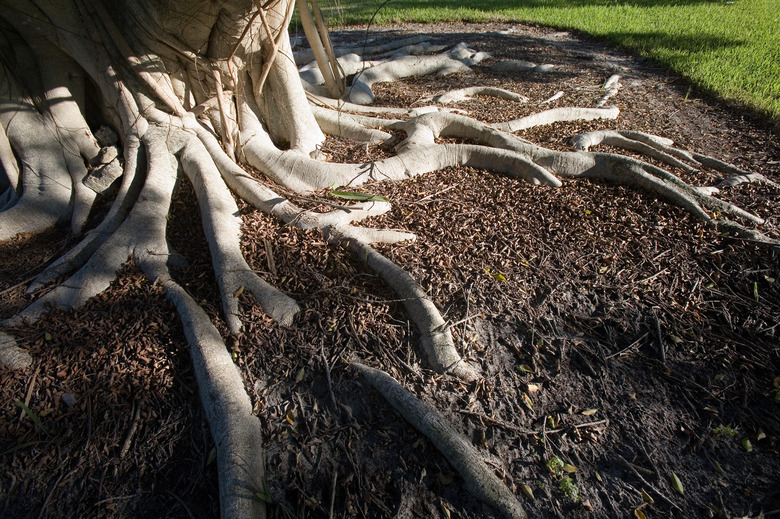How To Kill Tree Suckers
Trees with shallow roots commonly develop strong upright shoots called suckers. Some tree species are more prone to develop root suckers than others, including Bradford pears (Pyrus calleryana) and tree of Heaven (Ailanthus altissima). Herbicides applied to suckers can kill the entire tree, so the best control method is to persistently cut back the suckers and hope they don't grow back. If the tree is already cut, herbicides can be used to completely kill the suckers because you won't risk killing the tree. Eventually, the suckers absorb enough herbicide to kill the roots and stop new sucker growth.
Live Trees
Step 1
Step 1
Dig into the soil around the root suckers without disturbing the tree roots. Use a garden trowel, which allows you to dig shallow depths more carefully.
- Trees with shallow roots commonly develop strong upright shoots called suckers.
- Herbicides applied to suckers can kill the entire tree, so the best control method is to persistently cut back the suckers and hope they don't grow back.
Step 2
Step 2
Cut the sucker as far down below ground as possible, using bypass pruners.
Step 3
Step 3
Bury the remaining root sucker with the soil you removed when you dug around it. The object is to prevent sunlight from reaching the sucker, which can cause it to grow back.
Step 4
Step 4
Cut water sprouts, which grow upright from branches, about 1/4 inch above where each one meets the parent branch. Water sprouts are a type of sucker that grow straight up along branches and in the elbows of branches. They rarely develop into healthy branches, but can interfere with the strong branches in the canopy.
Cut Trees
Step 1
Step 1
Mix a 2 to 3 percent glyphosate or triclopyr herbicide in a gallon or half-gallon jug. If you don't purchase a ready-to-use herbicide product, you must dilute concentrated herbicide with water. Use water to mix the product, rather than a surfactant, because water is better able to travel through the vascular transport system and into the roots. The amount of herbicide to dilute depends on the concentration of the product. For example, to achieve a 2 percent solution from 41 percent glyphosate products, mix at a rate of 2 2/3 ounces glyphosate per 1 gallon of water.
- Cut the sucker as far down below ground as possible, using bypass pruners.
- Cut water sprouts, which grow upright from branches, about 1/4 inch above where each one meets the parent branch.
Step 2
Step 2
Place the jug of herbicide beside the root sucker. Mound sand, soil or gravel around the jug to hold it upright.
Step 3
Step 3
Cut the tip of the sucker at a 45-degree angle, using bypass pruners or a sharp knife. Leave the sucker about 2 to 3 feet long.
Step 4
Step 4
Push the cut tip of the root sucker into the jug of herbicide. Use clothespins or a similar clip to hold the root sucker in place if it rises up out of the jug; the extra length of the root sucker should prevent the sucker from backing out of the jug. If two or three narrow root suckers are within close proximity of the jug, you can push multiple suckers in the jug. If you have multiple root suckers that can't easily reach the jug, you must use one jug of herbicide for each root sucker.
- Place the jug of herbicide beside the root sucker.
- If two or three narrow root suckers are within close proximity of the jug, you can push multiple suckers in the jug.
Step 5
Step 5
Remove the suckers from the herbicide jug after allowing them to drink the herbicide into the roots for 48 hours. Dig out the base of the sucker, and cut it below ground level. Label the jug, replace the cap and store it for future use. Repeat this process as new root suckers develop. Allow the suckers to reach 2 to 3 feet long before treatment. It may take several applications with multiple root suckers, but the suckers eventually transpire enough herbicide to kill the roots and prevent future suckering.
Tip
Bradford pears thrive in U.S. Department of Agriculture plant hardiness zones 5 through 9. Tree of Heaven are hardy in USDA zones 4 through 8.
Tip
A 1/2- to 1-gallon jug works well for treating large trees with large root suckers. If you have a smaller tree, you can use a smaller container, such as a 1-quart jug or empty aluminum can.
Things Needed
- Garden trowel
- Bypass pruners
- Glyphosate or triclopyr herbicide
- Gallon or half-gallon jug
- Sand, soil or gravel
- Sharp knife
- Clothespins
